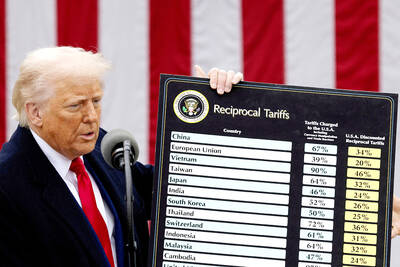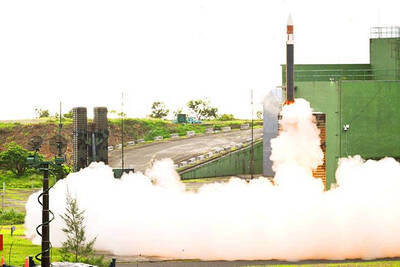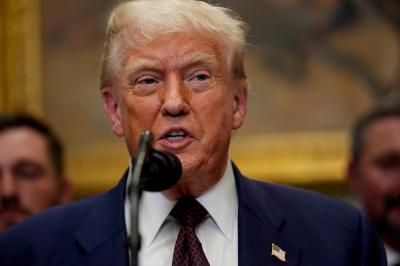Fireproofing, sprinkler systems and the water supply for hoses were all disabled in the World Trade Center's twin towers on Sept. 11 in the face of a blaze so intense that it drove temperatures as high as 2,000fWhat is already clear is that the jet plane fuel played a somewhat different though still critical role from some experts had speculated.
For example, after the planes slammed into the towers, the fireballs that burst over Lower Man-hattan consumed perhaps a third of the 38,000 liters of jet fuel on board each plane, but did little structural damage themselves, the report says.
Like a giant well of lighter fluid, though, the remaining fuel burned within minutes, setting ablaze furniture, computers, paper files and the planes' cargo over several floors and igniting the catastrophic inferno that brought down the towers.
Under normal circumstances, fire suppression systems are designed to allow a high-rise blaze to burn itself out before the building collapses. But the report concludes that there were across-the-board failures in the fire suppression systems inside the towers, raising disturbing questions about the safety and integrity of other tall buildings in out-of-control fires. But the ultimate significance of those failures is extremely difficult to gauge, the report says, because the extraordinary circumstances of attacks.
In fact, besides just setting the fires, the impact of the jets may have jarred loose the light, fluffy fireproofing that had been sprayed on steel columns, and flying debris almost certainly sliced through the vertical pipes that supplied water for the hoses and sprinklers.
Because of those uncertainties, the report says, the possibility of changes to building codes and engineering practices should receive extensive further study, a step the federal government is already planning, with a US$16 million, two-year inquiry by the National Institute of Standards and Technology now getting underway. The report's final version may recommend specific changes in building codes and standards.
The report is also significant for what it does not include. With the exception of a few torn, contorted steel beams from 5 World Trade Center, a nine-story office building on the site that also burned and suffered localized collapses because the beams failed where they were bolted together, not a single piece of evidence collected from the piles of debris contributed in a meaningful way to the report's conclusions.
That gap could intensify criticism of an early decision by the city to recycle steel from the trade center rather than make it immediately available for collection and analysis by the team. Some 60 pieces of trade center steel are being sent to the National Institute of Standards and Technology for the continuing investigation, so it is possible that future analysis of the steel remnants could provide additional answers.
The draft report also does not contain any discussion of what could, potentially at least, become an explosive new issue in attempts to explain why the south trade tower, though struck after the north tower, fell first. That issue involves a program, started after the 1993 bombing of the towers, to increase the the thickness of the fireproofing on the lightweight steel joists that held up the floors in the trade center.
At the time of the attack, 18 floors on the north tower and 13 floors in the south tower had been upgraded, by increasing the thickness of the fireproofing from 2cm to 4cm. But as it happened, the planes hit floors in the north tower whose fireproofing thickness had already been increased, and floors in the south that had not -- with one exception, the 78th floor.
Team members are carefully debating what role that difference may have played in the time the towers stood after impact: 56 minutes, 10 seconds for the south tower and 102 minutes, 5 seconds for the north. But there are several other possible explanations. The plane that struck the south tower was moving at least 160kph an hour faster than the other -- heightening the energy upon impact. And it hit ten floors lower, resulting in far more weight bearing down on the damaged area.
Whatever its thickness, much of the fireproofing was probably dislodged by the impact of the planes, the investigators concluded. One official knowledgeable about the fireproofing said that even with the wipe of a finger, the woolly, mineral-based material could be brushed away.
Stripped of its fireproofing, a steel column heats up much more quickly in a fire. The hotter the steel, the less it is able to support loads, as it eventually becomes soft as licorice. Investigators believe the structural steel was also greatly imperiled because the sprinklers and standpipes supplying water for firefighting were almost certainly disabled, their supply pipes cut by flying debris in the initial crash.
The sprinklers were installed by about 1990 and included tanks as high as the 110th floor of the buildings. Witnesses below the areas of impact, and therefore below the primary fires, described water cascading down the stairwells where pipes from those tanks ran. The hoses that firefighters carried on their backs up the same stairwells would therefore have been largely useless, since the standpipes used the same supplies.
"Damage caused by the aircraft impacts is believed to have disrupted the sprinkler and fire standpipe systems," the report says.
The report cites the tightly clustered exit stairways, three per tower, as a factor that may have made it easier to cause damage to all of them with one blow. These exit stairwells also had relatively lightweight gypsum board sheathing, providing little armor. Partly for these reasons, thousands of people above the floors of impact in the towers were trapped and killed.
Most of the tenants in the floor below impact, to the credit of the building and the emergency lighting in the stairwells, escaped. More than 400 firefighters, police officers and other rescue personnel and dozens of tenants who stayed behind during the evacuation were also killed when buildings finally collapsed. An estimated 2,830 people are considered dead or missing in the tower disaster.
Against the Manhattan skyline, the gleaming towers looked nearly identical, except for the television tower atop the north tower. But the inquiry has found that the forces that brought them down had distinct differences.
Their basic structures before the attacks were extremely similar, even if they were not quite perfect twins. Each tower was supported against the downward force of gravity by a tightly arranged matrix of columns at its core and another palisade of columns, spaced just 120cm, around its exterior.
The core and perimeter columns were connected by lightweight, weblike floor supports called trusses at each floor. The trusses held up corrugated metal decks on which the concrete floors were poured. The same trusses provided lateral support for all the vertical columns, preventing them from buckling under the tremendous force of gravity.
Wide plates called spandrels tied the exterior steel columns together, creating a rigid surface that could resist hurricane-force winds.
All of these structural elements would become fateful as the jets plowed into the north tower at 8:46am and the south tower at seconds before 9:03am.
The report -- assembled with data collected at ground zero, in scrapyards and laboratories, and by analyzing more than 100 hours of videotapes and by interviewing to witnesses -- turned up the greatest amount of detail on south tower attack.
The United Airlines Flight 175, its wings slightly canted, angled into the south facade of the south tower, slicing through about 30 of the 59 exterior columns on that face. The immediate damage, probably including unseen devastation to the steel core, stretched from the 78th to the 84th floor.
The impact of plane, which had been traveling as fast as 940kph, was so great that it gathered office material like a snowplow and apparently forced it toward the northeast corner of the building. Parts of the plane came to rest there and others punctured the far wall, soaring as far as six blocks to the north before hitting the ground near the intersection of Murray and Church streets.
A fuel-fed fireball emerged from three sides of the tower and consumed roughly one-third of the estimated 38,000 liters on the plane. Some of the rest flowed down the face of the building and into elevator shafts and stairwells. What remained burned ferociously, setting acres of office space afire as well as the luggage and other items that had been carried by the plane.
The incredible energy generated by this blaze was estimated at its peak to be between three and five gigawatts. A typical nuclear power plant generates about one gigawatt. All of that energy was converted to deadly heat that began weakening the steel.
But the tower did not fall immediately. Preliminary calculations by the engineering team have revealed that the tight spandrel connections, built to resist the wind, gave the building a remarkable ability to redistribute loads from severed columns to those that remained intact. A separate structure at the top, called a hat truss, also allowed loads to pass between the exterior and the core.
This rearrangement was so efficient, the calculations show, that stresses on columns no more than 6m from the hole punched in the tower's face were scarcely above what they carried before the damage occurred. Like a horse with a bum leg, the buildings, though wounded, still stood.
But the fires continued to burn. Black smoke poured from shattered windows on floor after floor, fresh oxygen sucked in from the gaping holes caused by the impacts. In the northeast corner of the building's 80th floor, where office furniture had been shoved by the plane, the fire burned so hot that a stream of molten metal began to pour over the side like a flaming waterfall.
The apparent source of this waterfall: molten aluminum from the airliner's wings and fuselage, which had also piled up in that corner. Within minutes, portions of the 80th floor began to give way, as evidenced by horizontal lines of dust blowing out of the side of the building. Seconds later, near the heavily damaged southeasterly portion of this same floor, close to where the aircraft had entered, exterior columns began to buckle.
Fifty-six minutes and 10 seconds after it was hit, the top of the south building tilted horribly, to the east and then to the south, and initiated the collapse of the entire tower, floor upon floor.
Unfolding at a slower pace, the disaster at the north tower will require study before it can be explained in such detail. The plane entered the north tower between the 94th and 98th floors, the report says, destroying about 35 columns on its north face and wreaking indeterminate but probably substantial damage to the core.
The building stood for 102 minutes and 5 seconds.

WAITING GAME: The US has so far only offered a ‘best rate tariff,’ which officials assume is about 15 percent, the same as Japan, a person familiar with the matter said Taiwan and the US have completed “technical consultations” regarding tariffs and a finalized rate is expected to be released soon, Executive Yuan spokeswoman Michelle Lee (李慧芝) told a news conference yesterday, as a 90-day pause on US President Donald Trump’s “reciprocal” tariffs is set to expire today. The two countries have reached a “certain degree of consensus” on issues such as tariffs, nontariff trade barriers, trade facilitation, supply chain resilience and economic security, Lee said. They also discussed opportunities for cooperation, investment and procurement, she said. A joint statement is still being negotiated and would be released once the US government has made

Authorities have detained three former Taiwan Semiconductor Manufacturing Co (TMSC, 台積電) employees on suspicion of compromising classified technology used in making 2-nanometer chips, the Taiwan High Prosecutors’ Office said yesterday. Prosecutors are holding a former TSMC engineer surnamed Chen (陳) and two recently sacked TSMC engineers, including one person surnamed Wu (吳) in detention with restricted communication, following an investigation launched on July 25, a statement said. The announcement came a day after Nikkei Asia reported on the technology theft in an exclusive story, saying TSMC had fired two workers for contravening data rules on advanced chipmaking technology. Two-nanometer wafers are the most

NEW GEAR: On top of the new Tien Kung IV air defense missiles, the military is expected to place orders for a new combat vehicle next year for delivery in 2028 Mass production of Tien Kung IV (Sky Bow IV) missiles is expected to start next year, with plans to order 122 pods, the Ministry of National Defense’s (MND) latest list of regulated military material showed. The document said that the armed forces would obtain 46 pods of the air defense missiles next year and 76 pods the year after that. The Tien Kung IV is designed to intercept cruise missiles and ballistic missiles to an altitude of 70km, compared with the 60km maximum altitude achieved by the Missile Segment Enhancement variant of PAC-3 systems. A defense source said yesterday that the number of

Taiwanese exports to the US are to be subject to a 20 percent tariff starting on Thursday next week, according to an executive order signed by US President Donald Trump yesterday. The 20 percent levy was the same as the tariffs imposed on Vietnam, Sri Lanka and Bangladesh by Trump. It was higher than the tariffs imposed on Japan, South Korea and the EU (15 percent), as well as those on the Philippines (19 percent). A Taiwan official with knowledge of the matter said it is a "phased" tariff rate, and negotiations would continue. "Once negotiations conclude, Taiwan will obtain a better